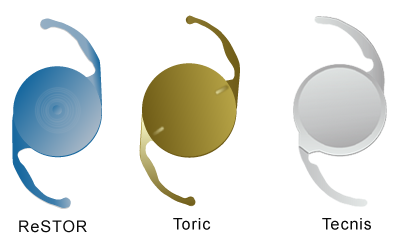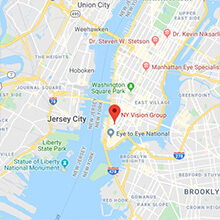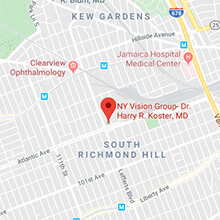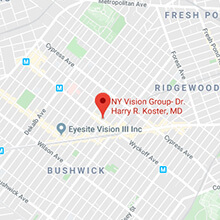For LASIK patients who are not good candidates for traditional LASIK, another option is a refractive lens exchange (RLE) with a multifocal or accommodating lens. RLE is particularly attractive for LASIK patients who have high refractive errors, thin corneas, dry eyes, cornea problems, or a combination of these conditions, which make traditional LASIK less appropriate. It is also more effective at treating both refractive errors and restoring near vision in patients over 40 years old. Refractive Lens Exchange (RLE) is essentially cataract surgery but exclusively for refractive purposes, because the lens that is removed is not clouded with a cataract. RLE is sometimes called Clear Lens Exchange (CLE), Clear Lens Extraction (CLE), or Refractive Lens Replacement (RLR).

During the procedure, the natural lens of the eye is removed and replaced with a foldable implant. To achieve the best vision correction and widest range of vision, a multifocal lens such as the Tecnis or ReSTOR, or an Extended Depth of Focus (EDOF) lens such as the Tecnis Symfony, are recommended. These premium IOLs provide the broadest range of vision with less chance of patients requiring glasses, helping reduce the possibility of presbyopia. Another premium lens option, used to treat astigmatism, is the AcrySoft Toric lens.
Because RLE is a procedure that involves both the equivalent of cataract surgery and the possibility of refractive surgery, it is important to look for a surgeon such as Dr. Harry Koster, who has both extensive cataract experience and extensive cornea-based refractive surgery experience.
Which LASIK Implant Option is Right for Me?
At your consultation, the doctors and staff at NY Vision Group will review your options and help identify which procedures best suit you, based on your lifestyle and your visual needs. If cost is an issue, we offer several financing options and will work with you as best we can to meet your vision goals. The following is a brief description of the premium lens options that NY Vision Group offers in New York.
AcrySof ReSTOR
 The AcrySof ReSTOR lens is a premium implant that can restore a range of vision with increased independence from glasses or contact lenses. For most patients, the ReSTOR IOL delivers excellent near and far vision and good intermediate vision without reading glasses or bifocals. In fact with this increase in vision quality, ReSTOR patients would be able to pass the visual acuity part of the driver’s license exam in most states (without glasses!). The AcrySof ReSTOR lens is a unique technological innovation which is particularly well suited for patients who would like to have a chance of eliminating glasses.
The AcrySof ReSTOR lens is a premium implant that can restore a range of vision with increased independence from glasses or contact lenses. For most patients, the ReSTOR IOL delivers excellent near and far vision and good intermediate vision without reading glasses or bifocals. In fact with this increase in vision quality, ReSTOR patients would be able to pass the visual acuity part of the driver’s license exam in most states (without glasses!). The AcrySof ReSTOR lens is a unique technological innovation which is particularly well suited for patients who would like to have a chance of eliminating glasses.
How Does ReSTOR Work?
As we perform daily activities such as reading, watching television or working on the computer, our eyes are constantly changing focus through a process known as “accommodation”. This task is performed by the lens of the eye, which changes shape, or accommodates, to allow the eye to focus at different distances. As we age, however, our lens loses the ability to change shape and thus our accommodating ability diminishes, causing us to become more dependent on bifocals or reading glasses. The Acrysof ReSTOR IOL is a foldable IOL lens that was designed to overcome this dependence, helping correct for the condition known as presbyopia. It features the latest of apodized and refractive technologies similarly used in microscopes and telescopes to improve image quality.
Clinical Studies
During ReSTOR’s clinical studies, patients experienced lifestyle enhancement through quality vision and greater freedom from reading glasses and bifocals. In fact, according to these clinical studies, four out of five patients who received ReSTOR lenses in both eyes reported never wearing glasses following their surgery, compared to only 1 out of 10 patients who received standard monofocal lenses. This is the highest level of freedom from glasses ever demonstrated in an IOL clinical trial.
Typically there is an adjustment period for the ReSTOR, and all multifocal implant lenses, as a patient’s brain learns to see up close and at a distance. Also, as with all multifocal lenses, some patients report halos or glare around lights after their surgery. However, only 5% of patients receiving the ReSTOR implant had noticeable nighttime halos, and most of those reported decreased symptoms over time. Most patients reported that their ability to see near, intermediate and far distances outweighed any visual side effects.
TECNIS
 The Tecnis IOL is a multifocal IOL designed to give patients an increased range of vision. The Tecnis is the most recent innovation in lens implant technology and is the first IOL with a patented wave-front designed optic for recreating more youthful vision. It is specifically designed to provide safer, sharper vision at any distance and any light condition.
The Tecnis IOL is a multifocal IOL designed to give patients an increased range of vision. The Tecnis is the most recent innovation in lens implant technology and is the first IOL with a patented wave-front designed optic for recreating more youthful vision. It is specifically designed to provide safer, sharper vision at any distance and any light condition.
Peak vision usually occurs at age 19, when a person has zero spherical aberrations (i.e. zero distortions in vision) and when contrast sensitivity and quality of vision peak. As we age, however, the eye’s spherical aberration (distortion) increases, reducing functional vision. Spherical aberration causes diffusion of light resulting in blurred vision, reduced contrast sensitivity and decreased function. The Tecnis IOL addresses this problem as it is designed to reduce spherical aberration. In fact,
a clinical study showed that the average ocular spherical aberration of Tecnis IOL eyes was not significantly different than zero, i.e. approximately the youthful vision of a 19-year old.
How Does TECNIS Lens Work?
The Tecnis Multifocal lens replaces the natural lens and is implanted into the eye during cataract surgery. It has a patented optic design that works like a bifocal lens inside the eye. For long-distance vision, the Tecnis multifocal lens creates a clear image of the far-away object while at the same time a second, a highly defocused image is created for near vision that is typically not perceived. For near vision, the Tecnis multifocal lens creates a clear, sharply focused near the image and a second highly defocused far away image that is typically not perceived. This unique multifocal optic design gives it the ability to provide clear vision near, far and in-between without mechanical movement of the lens. Because the Tecnis multifocal lens does not work with the muscles of the eye, it is not dependent on a mechanical process or the movement of the lens to give clear vision.
The Tecnis Multifocal lens is similar to two lenses in one. One, a refractive lens is for distance, the other, a lens for near vision. This gives the Tecnis multifocal IOL more consistent results and more satisfied patients who can enjoy activities like reading, sewing, seeing their smartphone or looking at the fine print on documents, all without the hassle of reading glasses, bifocals, progressive lenses or contact lenses.
Clinical Studies
The Tecnis multifocal IOL has been shown in a clinical study to provide good near, intermediate and distance vision with increased independence from glasses in patients who have undergone cataract surgery. Patients with the Tecnis multifocal lens in both eyes have a 90% chance of not needing glasses for any activity. Results from a controlled clinical study of the Tecnis multifocal IOL revealed that maximum visual performance is achieved when the lens is implanted in both eyes. Benefits are apparent with individuals in whom the lens is used in only one eye as well.
Clinical data demonstrates that the Tecnis multifocal IOL greatly reduces dependence on glasses or bifocals:
- Over 94% of patients said they would choose the Tecnis multifocal lens again.
- Nearly 9 out of 10 patients enjoy freedom from glasses after receiving the Tecnis multifocal lens.
Furthermore, the Tecnis can provide significant improvement in functional vision, including potentially improving driving vision. In studies submitted to the FDA, the TECNIS lens improved the identification distance for a pedestrian hazard by 14 meters compared to a traditional spherical lens implant (resulting in an additional half-second to perceive and react to a driving hazard).
Nonetheless, everyone’s focusing ability is different. Most people will be able to see clearly in the distance, have very good reading vision and functional intermediate vision without glasses, but some people may be more comfortable with additional correction, particularly for long periods of computer work. After surgery with the Tecnis multifocal lens, it may be necessary for some people to wear glasses for distance, intermediate and/or near vision to obtain optimal visual acuity. The difference from basic lenses is that most people will not be as dependent on these supplemental vision aids to function normally.
Tecnis Symfony
The Tecnis Symfony is an Extended Depth of Focus (EDOF) Presybyopia-Correcting IOL that provides continuous, high-quality vision at any distance. It is intended to provide high-quality vision from near to far and points in between and may reduce the frequency of wearing glasses. The Tecnis Sympfony was approved by the FDA for cataract use in 2016.
How Does the Tecnis Symfony Work?
Tecnis Symfony New York
The Tecnis Symfony is the first lens of its kind to combine two unique technologies for outstanding visual performance: 1) elongating the focus of the eye to provide continuous, high-quality vision; and 2) correcting chromatic aberration (color distortion) to provide sharp vision in all lighting conditions.
With Tecnis Symfony patients may be able to comfortably enjoy low-light activities such as taking a walk at dusk, going to the movies or even driving at night. Some patients do experience a loss of sharpness, which may become worse under poor visibility conditions such as dim light or fog. In addition, as with any surgical procedures, inherent risks exist with all multifocal implants, whether the Symfony or ReSTOR, and a patient’s results cannot be guaranteed.
FDA Clinical Trial Information
- 77% of patients receiving Tecnis Symfony implants had good vision(20/25) without glasses at an intermediate distance, compared to 34% of patients who received standard monofocal implants
- For near distances, patients with the Tecnis Symfony lens were able to read two more progressively smaller lines on a standard eye chart vs. patients receiving monofocal implants.
- Both sets of patients had comparable results of good distance vision.
- At the six month visit, 85% of the Symfony patients reported wearing glasses a little or none of the time in the week prior to their visit.
Acrysof Toric Lens
 The Acrysof Toric lens implant differs from the multifocal implants described above in that it was specifically designed for patients who have a significant amount of astigmatism. In the past, when patients with significant astigmatism had cataract surgery, they would still require glasses for near and distance vision (because of their astigmatism). The design of the Acrysof Toric lens makes it possible to reduce or eliminate astigmatism and improve uncorrected distance vision. As with the other premium multifocal implants described above, there is an additional cost for this lens implant. However, we strive to make all of these lenses affordable through our various payment options.
The Acrysof Toric lens implant differs from the multifocal implants described above in that it was specifically designed for patients who have a significant amount of astigmatism. In the past, when patients with significant astigmatism had cataract surgery, they would still require glasses for near and distance vision (because of their astigmatism). The design of the Acrysof Toric lens makes it possible to reduce or eliminate astigmatism and improve uncorrected distance vision. As with the other premium multifocal implants described above, there is an additional cost for this lens implant. However, we strive to make all of these lenses affordable through our various payment options.
Which Premium Lens Implant is Right for Me?
If you are like many New York patients seeking lens implants you are probably wondering which implant is right for me? During your consultation, the doctors and staff at NY Vision Group will discuss with you the various premium implant options and which one is the best solution for you based on your lifestyle and your specific visual needs. Each of the premium lens implants options has unique attributes that may or may not be beneficial for you.
What are the Risks?
ens replacement surgery is identical to cataract surgery and results in safe and successful outcomes in approximately 98% of eyes treated. Like any surgical procedure, there are risks. During your visit to NY Vision Group the risks, benefits and surgical alternatives will be discussed with you. Some visual effects associated with multifocal IOLs may be expected because of the superposition of focused and unfocused images. These may include a perception of halos/glare around lights under nighttime conditions. It is expected that, in a small percentage of patients, the observation of such phenomena will be annoying and may be perceived as a hindrance, particularly in low illumination conditions. On rare occasions, these visual effects may be significant enough that the patient will request the removal of the multifocal IOL. Additionally, individuals who are planning on receiving a multifocal lens may need an additional procedure to “fine-tune” their vision.




